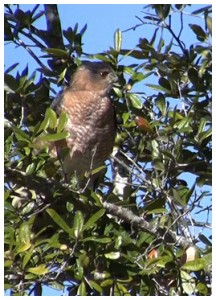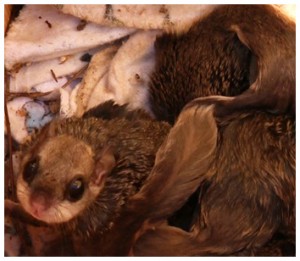Sharp-shinned hawk and flying squirrels released at Hammock Bay

Joe Wyatt, naturalist at Hammock Bay in Freeport shared a recent morning with me to witness the release of a rehabilitated sharp-shinned hawk and four juvenile flying squirrels.
Lisa Miller of Wildlife Rehabilitators in Niceville recently rehabilitated the animals. When the animals were healed, Lisa handed them off to Joe for release back into the wild.
The sharp-shinned hawk was discovered with a cut between her wings. The cause of the injury is not known, however Joe guessed it could of be inflicted by another raptor. The squirrels were found abandoned.
“An open area with trees nearby is a good location for the bird to get its bearings,” Joe informed me. So we then headed into a suitable place for her release.
I could tell the hawk was more than ready to break free from the cumbersome restraints of the crate as she flapped her wings in anticipation. As soon as Joe opened the door, the hawk took off and quickly landed on a branch of a tree nearby.
It took a few minutes for the bird to get her bearings. She seemed to like the high perch and 360 degree view of her surroundings.
I watched in awe as she scoped out the area, repositioning herself on the branches to get better views of her new territory. She stood sure of herself as she prepared for flight. After about 15 minutes, she took off and disappeared, off to find her new home.
What a beauty this sharp-shinned hawk was, with red eyes, a dove-colored back and a chest with a reddish hue, and tail feathers grey and black.
We then headed off to a wooded area for the release the baby flying squirrels.

The squirrels were in an old wooded bird box that had the openings temporarily sealed.
“Flying squirrels are nocturnal” Joe explained. The box openings were covered until their new home is mounted up in a tree,” as Joe unloaded a ladder from the top of his truck.
Joe opened the box briefly to let me take a peek and share a closer look at these little cuties. Their eyes were so big and black, almost disproportionate to the rest of their tiny bodies. They looked so soft, it was hard to resist not picking one up.
“Flying squirrels are also cavity nesters,” Joe explained. “The bird box makes a suitable habitat for them right now.”
What a great way to spend a chilly morning. I didn’t seem to mind the cold air at all, for I was preoccupied with the matters at hand.
Thanks Joe Wyatt for sharing and finding habitats for these creatures.
And thank you Lisa Miller of Wildlife Rehabilitators for giving these animals a second lease on life.
About the sharp-shinned hawk (Accipiter striatus)
Size: 9-13 inchesWingspan: 17-22 inchesWeight: 3.07 – 7.7 ounces
Cool Fact
After the young leave the nest, the adults pass food to the young in mid-air. The parents give the prize to the first young hawk to reach them, hovering briefly and kicking the prey outward just as the fledgling arrives.
Click here to listen to the sound of a sharp-shinned hawk
Information courtesy Cornell Lab of Ornithology
About the southern flying squirrel (Glaucomys volans) also known as:
Eastern Flying Squirrel
Flying squirrels are nocturnal and are much smaller than most tree squirrels, which are diurnal. Although primarily associated with hardwoods, especially oaks and hickories, Southern Flying Squirrels inhabit forests of diverse types, and even live in cities and suburbs. A natural cavity or old woodpecker hole in a live or dead tree is the typical nest site. Where the ranges of the two species of flying squirrels overlap, it appears the Southern Flying Squirrel may out-compete its larger relative.
Length:
Average: 231 mm
Range: 198-255 mm
Weight:
Average: 70 g
Range: 46-85 g
Information courtesy National Museum of Natural History
Venture Walton is a feature column for outdoor enthusiasts in Walton County, Florida.
Lori Ceier is the publisher of waltonoutdoors.com, and can be reached via email at info@waltonoutdoors.com
